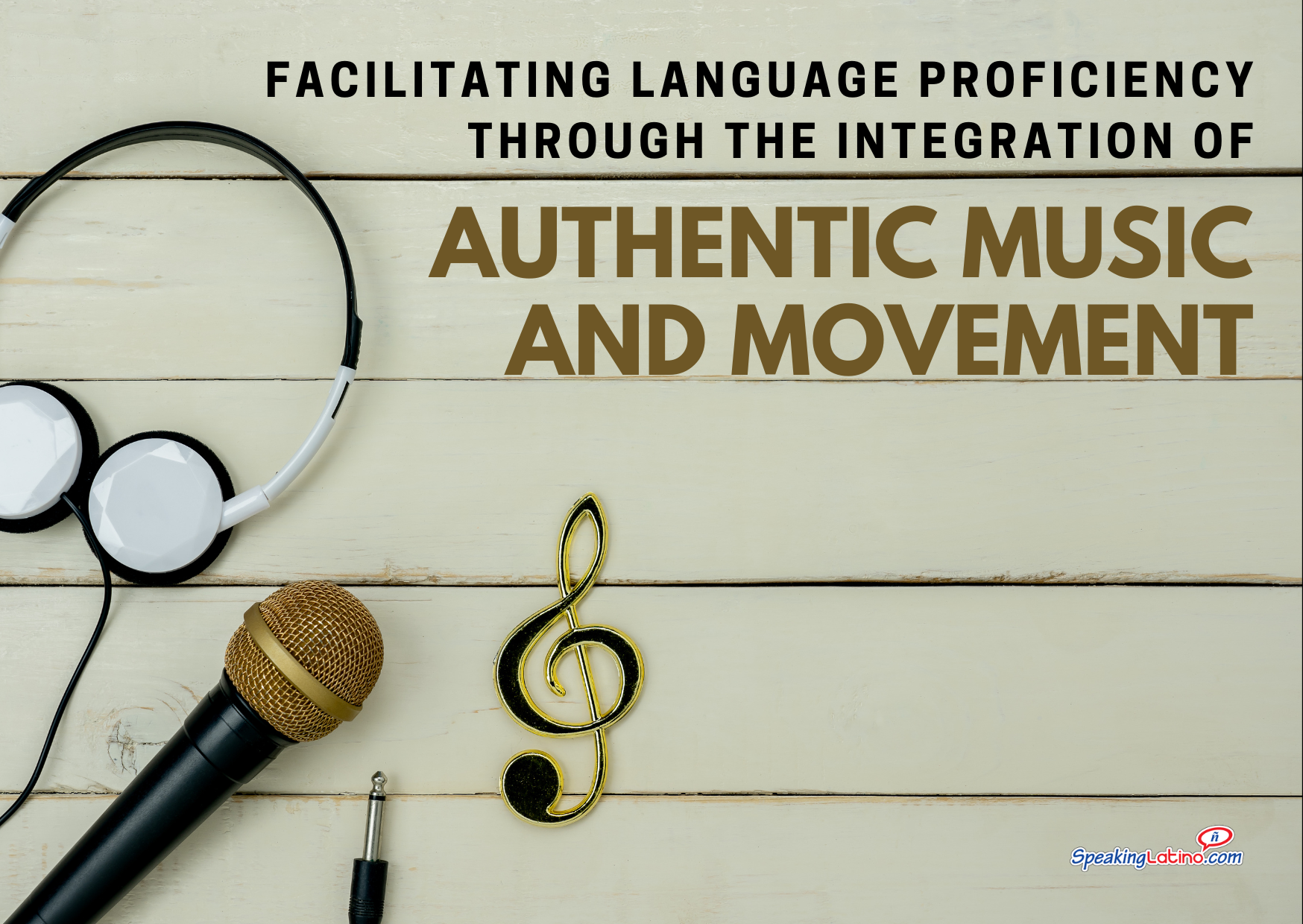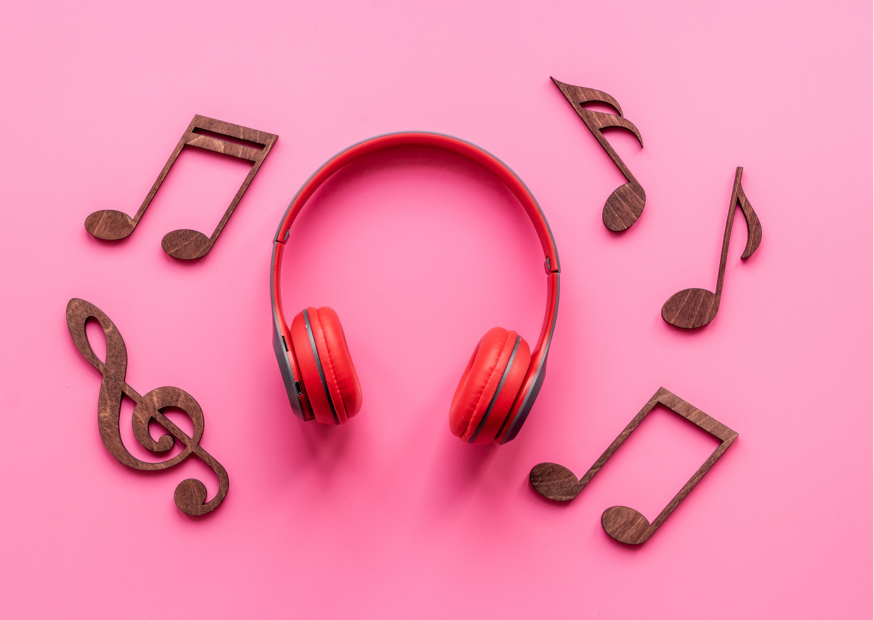
The content of this article is based on the presentation, Moving and Grooving! Using Authentic Music by Noemí Rodríguez, which was part of the World Language Teacher Summit.
The Transformative Power of Authentic Music and Movement in Language Education
In the realm of elementary language education, educators are continually seeking innovative and engaging methods to facilitate effective language learning experiences for their students. One particularly powerful approach to achieving this goal is the integration of authentic music and movement. We will delve into the vast benefits of incorporating authentic music and movement in language classrooms, explore various strategies and ideas for seamlessly infusing music into language lessons, and evaluate the potential impact of employing authentic music and movement in elementary education.
The Benefits of Using Music and Movement in the Classroom
The advantages of integrating music and movement into the elementary language classroom are multifaceted and far-reaching. These approaches serve to captivate and engage students in the language learning process, igniting their interest and involvement across diverse levels of engagement. Scientific research has unequivocally established that music accelerates brain development in young learners, making it a potent tool for enhancing cognitive abilities (Rodríguez, 2021).
Additionally, the inclusion of movement-based activities promotes physical activity, hand-eye coordination, and overall holistic development among students. Moreover, music fosters emotional connections and a communal sense among students, creating an infectious vibrancy and interactive ambiance within the language learning environment.
Integrating Authentic Music Within Elementary Themes
The effective integration of authentic music within elementary themes holds the potential to significantly enrich the contextual and cultural relevance of language learning. By artfully aligning music with specific thematic units, educators can create immersive and vibrant learning experiences for their students. This approach serves to enable students to forge meaningful connections with the target culture, products, perspectives, and practices, thereby deepening their understanding of the language within authentic real-world contexts.
Furthermore, the utilization of authentic music within elementary themes presents educators with opportunities to infuse cultural elements into the curriculum, nurturing a profound appreciation for diverse linguistic and cultural traditions.
Utilizing Strategies and Ideas for Integrating Authentic Music
The incorporation of authentic music in language instruction necessitates the strategic deployment of diverse teaching methods and activities to optimize students' learning experiences. One commendable strategy is to utilize music as a timer for classroom activities, and as a dynamic brain break that reinvigorates students, ensuring attentiveness and energy during the learning process.
Educators can also architect pre-reading, during reading, and post-reading activities centered around song lyrics, a move that significantly bolsters students' interpretive skills. Cloze activities and movie talks leveraging music videos can deftly engage students, enrich their comprehension of linguistic and cultural content, and evoke their enthusiasm for learning.
By accentuating products, perspectives, and practices of the target culture, educators can effectively and seamlessly embed authentic music into their lessons, nurturing a comprehensive and holistic approach to language learning.
Pre-teaching Vocabulary and Comprehension through Authentic Music
An integral facet of incorporating authentic music in language education entails the pre-teaching of vocabulary and assessing students' comprehension. Teachers can employ a gamut of visual aids, gestures, and images to pre-teach vocabulary, ensuring students possess a strong foundational grasp of the language before engaging with the music.
Subsequently, running dictation, quizzes, and interactive activities like dice games can consolidate vocabulary acquisition and comprehension, effectively preparing students for a profound engagement with authentic music. Movie talks and subsequent comprehension activities provide students with platforms to demonstrate their understanding and linguistic prowess, cementing their learning and enhancing language retention.
Demonstrating Comprehension and Assessment through Authentic Music
Assessing students' comprehension and language proficiency through authentic music necessitates a multifaceted approach. Educators can harness a spectrum of assessment methods, including interpretive activities on digital platforms, sequencing activities predicated on music videos or lyrics, as well as creative tasks such as story writing or drawing related to a song. Encouraging students to articulate their thoughts, emotions, and connections with the song engenders language fluency and cultural awareness.
Assessments can center on students' ability to make predictions, identify key elements in the music, and draw comparisons between characters or themes and their own experiences, fostering critical thinking and the practical application of language skills.

Music accelerates brain development in young learners
Encouraging Student Engagement and Empowerment
The inclusion of authentic music and movement in the elementary language classroom not only facilitates language learning, but also spurs student engagement and empowerment. Through meaningful activities and discussions surrounding authentic music, students are afforded an opportunity to cultivate creativity, self-expression, and an appreciation for cultural diversity. Music serves as a potent vehicle for espousing affirmative messages and values, a quality exemplified by the empowering lyrics prevalent in certain songs.
By championing authenticity and celebrating individuality, educators create an inclusive and nurturing environment where students are emboldened to express themselves and embrace linguistic and cultural diversity. Such an approach is aligned with the pedagogical imperative of nurturing holistic development and self-assurance among young learners.
FAQs About Authentic Music in the World Language Classroom
What are the benefits of using authentic music in the language classroom?
Using authentic music in the language classroom offers numerous benefits, including:
- Cultural Immersion: Authentic music exposes students to the culture of the target language, helping them understand the traditions, values, and perspectives of native speakers.
- Language Acquisition: Music provides a natural and enjoyable way for students to practice listening skills, improve vocabulary retention, and enhance pronunciation.
- Engagement: Music captures students' interest and emotions, making learning more enjoyable and motivating them to actively participate in language activities.
- Memory Enhancement: Melodies and rhythms in songs can aid in memory retention, helping students remember vocabulary and grammatical structures more effectively.
- Creativity and Expression: Music encourages creativity and self-expression through activities like singing, dancing, and interpreting song lyrics, allowing students to engage with the language in a meaningful way.
- Community Building: Collaborative activities involving music foster a sense of community in the classroom, promoting teamwork and cultural appreciation among students.
- Multisensory Learning: Music engages multiple senses, such as auditory and kinesthetic, providing a holistic learning experience that caters to different learning styles.
- Emotional Connection: Songs evoke emotions and create personal connections with the language, making learning more relatable and memorable for students.
- Brain Development: Research shows that music stimulates brain development in young children, enhancing cognitive abilities and supporting overall language learning.
- Cultural Understanding: Authentic music exposes students to the diversity of musical genres, styles, and artists from the target language's culture, broadening their cultural awareness and understanding.
How can music videos be used as a teaching tool in the language classroom?
Music videos can be valuable teaching tools in the language classroom in the following ways:
- Visual Context: Music videos provide visual context to accompany the lyrics, helping students better understand the meaning of the song and reinforcing vocabulary and grammar concepts.
- Cultural Insights: Music videos offer insights into the culture of the target language through visual representations of customs, traditions, and societal norms depicted in the video.
- Engagement: The dynamic and visually stimulating nature of music videos captures students' attention and maintains their engagement throughout the lesson.
- Listening Practice: Watching music videos allows students to practice their listening skills by following along with the lyrics and identifying words and phrases in context.
- Speaking Practice: Students can engage in speaking activities such as describing scenes from the video, discussing the themes portrayed, or sharing their interpretations of the visuals.
- Critical Thinking: Analyzing music videos encourages critical thinking skills as students interpret the imagery, symbolism, and messages conveyed in the video.
- Creativity: Music videos inspire creativity in students, prompting them to create their own visual representations of songs or storyboard their interpretations of the lyrics.
- Cultural Comparisons: Comparing music videos from diverse cultures or time periods can facilitate discussions on cultural differences, similarities, and global perspectives.
- Motivation: Using music videos as a teaching tool adds an element of fun and excitement to language lessons, motivating students to actively participate and learn.
- Authentic Language Use: Music videos expose students to authentic language use in a natural context, helping them develop their listening comprehension and language proficiency in a meaningful way.

Encouraging students to share their thoughts and emotions through music enhances language fluency and cultural awareness
What are some practical tips for implementing music in the classroom?
Some practical tips for implementing music in the language classroom, include:
- Using Music as a Timer and Brain Break: Incorporate music as a timer for activities and as a brain break to energize students.
- Designing Pre-Reading, During Reading, and Post-Reading Activities: Treat song lyrics like a reading passage and design activities around them to enhance students' interpretive skills.
- Creating Cloze Activities: Develop close activities to strengthen students' interpretive skills and engage them in analyzing song lyrics.
- Utilizing Music Videos for Movie Talks: Use music videos for movie talks by capturing screenshots, engaging in picture talk, or creating shared story writing activities.
- Engaging in Karaoke and Dance Competitions: Organize karaoke and dance competitions to make language learning fun and interactive for students.
- Making Predictions and Being Imaginative: Encourage students to make predictions, be imaginative about song content, and think about cultural aspects of the music.
- Highlighting Cultural Aspects: Infuse elements of the target culture into lessons by focusing on dance, music genres, artists, and countries of origin related to the music.
- Pre-Teaching Vocabulary and Using Gestures: Enhance students' understanding of music-related content by pre-teaching vocabulary, using gestures, and incorporating images.
- Encouraging Comparison and Contrast: Prompt students to compare and contrast characters in music videos with themselves to deepen their understanding of cultural perspectives.
- Incorporating Movement and Interaction: Engage students in movement activities, interactive discussions, and creative tasks related to authentic music to promote active participation in language classes.
Empowering Minds, Enriching Journeys: The Integrative Influence of Authentic Music and Movement in Language Education
The integration of authentic music and movement in elementary language education yields manifold benefits, encompassing cognitive development, cultural immersion, student engagement, and empowerment. Through an array of strategies and activities, teachers can seamlessly incorporate authentic music into language lessons, elevating language acquisition and kindling a deeper appreciation of cultural nuances among students. Furthermore, the integration of authentic music and movement stands as a catalytic force for constructing vibrant, inclusive learning environments wherein students feel emboldened to express themselves and embrace linguistic and cultural diversity.
As language educators persist in their quest to optimize the learning journey for elementary school students, the inclusion of authentic music and movement emerges as an enriching and transformative pedagogical approach that transcends the confines of traditional language instruction.